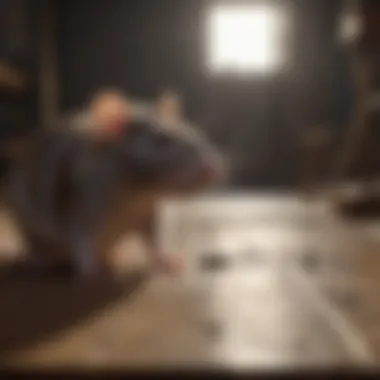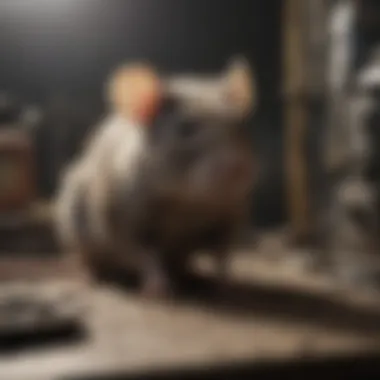Effective Rat Trapping Methods for Homeowners


Intro
Rats are not merely pests; they represent a significant issue for homeowners. Understanding their behavior and effective trapping methods is crucial for creating a rodent-free environment. This article explores a range of strategies designed to effectively address rat infestations in residential areas. By tackling identification and management tactics, homeowners will gain valuable insights that contribute to a safer living space.
Understanding Pests
Definition of Pests
Pests, particularly rats, are animals that cause problems when they invade human spaces. These creatures can damage property, contaminate food, and transmit diseases. The two most common species of rats that invade homes are the Norway rat and the roof rat. Each has distinct behaviors and habits that influence the trapping approach.
Importance of Pest Identification
Identifying the type of rat in your home is critical. It helps in understanding their nesting, feeding habits, and preferred habitats. For instance, Norway rats typically burrow in ground areas like gardens and basements. Roof rats prefer high places such as attics and trees. Understanding these behaviors ensures that the trapping methods used are tailored to be more effective.
Prevention Techniques
Home and Garden Preventative Measures
Preventing a rat infestation is often more effective than dealing with one after it occurs. Here are some home and garden measures to consider:
- Seal Entry Points: Check for holes in walls, foundations, and around pipes. Close openings with caulk or steel wool.
- Manage Waste: Keep garbage in sealed containers. Clean up fallen fruits or vegetables in gardens.
- Remove Clutter: In the house and yard, clutter provides shelter for rats. Keeping areas tidy makes them less appealing to these rodents.
Seasonal Prevention Tips
Adjusting prevention strategies based on seasons can be beneficial. For instance, autumn might bring increased rat activity as they seek warmth. Here are tips:
- In fall, inspect your home for cracks and crevices.
- During winter, ensure that food supplies are stored securely.
Eco-Friendly Pest Control Solutions
Overview of Sustainable Practices
Using eco-friendly pest control can mitigate the impact on the environment while effectively managing rat problems. Traps can be selected that do not harm the surrounding ecosystem. Encouraging natural predators, like owls, can help maintain the rodent population at manageable levels.
Natural Remedies and Their Effectiveness
There are several natural remedies that can deter rats from entering your home:
- Peppermint Oil: Applying it to entry points may repel rats.
- Ultrasonic Repellents: These devices emit high-frequency sounds that are said to deter rodents.
Remember, while natural remedies can aid in prevention, combining them with effective traps is often necessary for immediate issues.
Understanding Rat Infestations
Understanding rat infestations is crucial for effective management and prevention strategies. Rats pose significant risks not only to property but also to health. They can transmit diseases, contaminate food supplies, and cause structural damage through their gnawing habits. By learning about rat behavior, signs of their presence, and species commonly found in homes, homeowners can take proactive measures to protect their living spaces.
Overview of Rat Behavior
Rats are nocturnal creatures, primarily active during the night. Their behavior is characterized by agility and intelligence. They can adapt to various environments, which makes them particularly problematic for homeowners. Understanding their habits, such as nesting and foraging, aids in identifying potential hiding spots. Rats prefer to stay close to their food sources while maintaining pathways between their nests and feeding areas. This knowledge can guide homeowners in observing signs of rat activity within their homes.
Signs of Rat Presence
Detecting a rat infestation early is key to minimizing damage. Common signs include:
- Droppings: Rat droppings are often found near food sources or nests. They are typically dark, about the size of a grain of rice.
- Gnaw Marks: Look for gnaw marks on food packages, wooden structures, or wires. Rats need to gnaw continuously to keep their teeth from growing too long.
- Nests: Rats create nests from shredded materials such as paper and fabric, typically hidden in dark corners or storage areas.
- Noises: Scratching noises, scurrying sounds, or even squeaks may be heard at night, indicating active rats.
Identifying these signs can help in taking swift action.


Common Types of Rats in Homes
There are several species of rats that are often found in urban environments. Two of the most common are:
- Norway Rat: Also known as the brown rat, this species is heavy-set and prefers ground-level habitats. It digs burrows and can often be found in basements or beneath structures.
- Roof Rat: This species is lighter and more agile, often found in upper areas of homes, such as attics. They are excellent climbers and prefer to nest in trees or higher locations.
By understanding which species you are dealing with, you can tailor your trapping and prevention methods accordingly.
Assessing the Infestation
Assessing the infestation is a critical step in the process of dealing with rats in your home. Understanding the extent of the problem and identifying the specific areas affected can greatly influence the effectiveness of trapping methods. A thorough assessment helps in determining how many traps are needed and in which locations they should be set up. This can lead to a more efficient and targeted approach, reducing the time and resources spent on controlling the rodent population.
Conduct a Thorough Inspection
Carrying out a comprehensive inspection is vital to understand the severity of the infestation. Look for signs of rats in various parts of your home. Common places to check include basements, attics, and kitchens. You may notice droppings, gnawed items, or greasy marks along walls where rats frequently travel. Inspect any hidden areas, such as between appliances or in storage boxes. Keep in mind that rats are generally active at night, so signs may be more apparent during evening checks.
- Droppings: Fresh droppings are a key indicator that rats are present. They are typically dark and solid, and can indicate how recent the activity is.
- Gnaw marks: Look for bite marks on wood, plastic, or wiring. This can indicate both the presence of rats and the areas they frequent.
- Nests: Rats build nests from shredded materials like paper, fabric, and insulation. Finding nests is a clear sign of an established infestation.
Identifying Entry Points
After gathering information from the inspection, the next step is identifying how rats are entering your home. Rats can squeeze through surprisingly small holes, so careful examination of the exterior of your home is necessary. Pay attention to areas around pipes, vents, and doors. Look for:
- Cracks or holes: Inspect the foundation and walls for any gaps. Even a small opening can provide entry.
- Damaged screens or vent covers: Ensure that all screens and vent covers are intact. These can be potential entry points if not properly secured.
- Overhanging branches: Trim trees and shrubs near your house. Branches can provide a bridge for rats to reach windows and roofs.
Identifying entry points is essential for preventing future infestations. Sealing these areas will help secure your home.
Evaluating Damage and Risks
Once entry points have been identified, it is important to evaluate any potential damage to your property from the infestation. Rats can chew through wires, causing fire hazards. They can also contaminate food sources and spread diseases through their droppings and urine. Consider the following aspects:
- Structural damage: Check for any significant wear caused by gnawing. This can compromise the integrity of your home.
- Health risks: Rats are known carriers of various diseases. Understanding the health implications of an infestation can motivate prompt action.
- Cost implications: Evaluate any potential costs related to repairs or pest control services. This could help in budgeting effectively for extermination efforts.
Properly assessing the infestation is the foundation for effective rat trapping. By understanding the locations of the rats and evaluating how they affect your home, you can implement measures that yield effective results.
Selecting Trapping Methods
In dealing with rat infestations, selecting the right trapping method is crucial. Homeowners must understand the variety of traps available and how each type can affect the overall success of their rat management efforts. Choosing the correct traps plays a big role in eliminating the problem efficiently and humanely. Each method has its own advantages and disadvantages, which can significantly impact both immediate results and long-term effectiveness of pest control strategies.
Types of Traps
Snap Traps
Snap traps are among the most traditional and widely used methods for catching rats. The key characteristic of snap traps is their mechanism, which relies on a spring-loaded arm to deliver a quick, lethal blow. This results in an immediate kill, which is both effective and generally considered humane when set properly.
The unique feature of snap traps is their simplicity and ease of use. They are often baited with appealing foods, such as peanut butter or dried fruit, and positioned in areas where rat activity is observed. One major advantage of snap traps is their low cost, making them accessible for most households. However, a potential drawback is the need for careful placement, as improper setup could lead to missed catches or accidental harm to pets.
Glue Traps
Glue traps function differently from snap traps. These consist of a sticky surface that immobilizes rats upon contact. The primary characteristic of glue traps is that they do not kill the rodent outright, but rather leave it trapped until it succumbs to exhaustion or dehydration. This prolongs the suffering of the caught rat, which raises ethical concerns.
Glue traps are often considered a beneficial choice for homeowners seeking a non-toxic option. They require no baiting and are easy to set up. Their unique feature allows them to capture rats in tight spaces where other traps may not fit. On the downside, glue traps have a higher potential for a slow, painful death, making them less popular among those concerned with animal welfare. Furthermore, they are less effective in wet or humid conditions, as moisture can compromise their sticky surfaces.
Live Traps
Live traps are another option for capturing rats without lethal harm. The main aspect of live traps is their ability to allow for the removal and relocation of captured rats. These traps usually operate through an entry mechanism that closes once the rat is inside.
The appeal of live traps lies in their humane approach. They enable the user to catch and release rats safely, making them popular among those with ethical concerns regarding rodent control. A unique feature of live traps is their versatility; they can be used both indoors and outdoors. However, there are several disadvantages. Live traps require regular monitoring to ensure that rats do not suffer, and improper handling after capture can result in the rat becoming a problem in a new location. Furthermore, without proper bait selection and placement strategies, the effectiveness of live traps can be limited.


Evaluating Trap Effectiveness
When selecting traps, evaluating their effectiveness becomes essential. Factors such as the catch rate, ease of use, and humane considerations play significant roles. Homeowners should observe which traps yield the best results in their living environment and adjust their strategies accordingly.
Environmental Considerations
The impact of trapping methods on the environment should be assessed. Using eco-friendly traps and selecting non-toxic baits can contribute to sustainable pest control practices. Furthermore, ensuring proper disposal of trapped rats is important to minimize environmental risks.
Setting Up the Traps
Setting up traps correctly is crucial for the effectiveness of rat control measures. A well-planned trap setup can maximize the chances of capturing rats while minimizing disturbance to household routines. Understanding the principles behind effective trap placement and bait selection significantly influences the success of rat trapping.
Strategic Placement of Traps
Traps should be placed in areas where rat activity is most likely. Here are some points to consider:
- High Traffic Zones: Look for signs of rat presence such as droppings or gnaw marks. Ideal locations include near food sources, along walls, and around entry points.
- Hiding Spots: Rats feel safe in dark and concealed locations. Placing traps near these sites might increase capture rates. These places include behind appliances or inside cabinets.
- Optimal Distance: Traps should be set within a few feet of where you see evidence of rats. This helps ensure that they find the traps enticing.
Using a combination of different types of traps may also yield better results.
Bait Selection and Application
Choosing the right bait can be pivotal in attracting rats to your traps. Effective bait options should be appealing to them while also being easy to apply.
Popular bait choices include:
- Peanut Butter: Its strong smell and sticky consistency make it hard for rats to resist.
- Seeds or Nuts: These can attract rats fast, especially if they are already scavenging for food.
To apply bait effectively, follow these steps:
- Place a small amount of bait directly on the trigger of snap traps or in the middle of glue traps.
- Ensure that the bait is securely attached to avoid rats escaping with it.
- Replenish bait regularly to maintain its freshness and attractiveness.
Monitoring and Checking Traps
Regularly checking traps is necessary for effective rat management. It allows for the timely removal of captured rats and helps determine if adjustments are needed.
- Frequency of Checks: Aim to check traps at least once daily or more frequently if a large infestation is suspected.
- Recording Results: Keep a log of captured rats and any signs of continued activity. This data can help you assess the overall effectiveness of your trapping strategy.
- Disposal: Dispose of captured rats humanely, following local regulations. Always wear gloves when handling traps to ensure safety and hygiene.
Remember: A proactive approach, including regular maintenance and monitoring of traps, can significantly reduce the likelihood of reinfestation.
Setting up traps with care can make the difference between a minor issue and a larger infestation. Proper trap placement, effective bait, and regular monitoring will enhance the likelihood of resolution in rat management.
After the Capture
After successfully capturing a rat, it is critical to understand the next steps to take. The phase dubbed "After the Capture" plays a significant role in managing rat populations within residential environments. It encompasses safe disposal methods, cleaning, sanitizing the affected areas, and taking preventive measures to avert reinfestation. This post-capture phase ensures that not only is the immediate issue addressed, but long-term solutions are implemented to maintain a rat-free home.
Safe Disposal Methods
Disposing of captured rats must be approached with care and responsibility. There are several methods to consider, with the goal of ensuring safety for the individual and the environment.
- Secure disposal in plastic bags: Remove the rat from the trap using gloves. Place it into a plastic bag and securely tie it. Dispose of this bag in an outdoor trash bin, if local ordinances permit.
- Contact local animal control: In some areas, residents can contact animal control for assistance. They may have specific recommendations based on local wildlife laws.
- Composting: Some may consider composting if local regulations allow, but this should only be done if certain that the rat was disease-free.
It is essential to check local regulations regarding wildlife disposal in your area.
Cleaning and Sanitizing Affected Areas
After a rat is captured, cleaning the area is crucial to remove any remnants that could foster health risks. Rats can carry various diseases. Proper cleaning and sanitization help reduce the potential for disease transmission.
- Use gloves: Always wear gloves when cleaning.
- Wash surfaces: Clean any surfaces where the rat or its droppings have contacted. Use a mixture of disinfectant and water to thoroughly scrub these areas.
- Dispose of contaminated materials: Items such as bedding or stored food that were contaminated should be disposed of properly.
- Ventilate the area: Make sure the space is well-ventilated during and after the cleaning process to minimize exposure to harmful contaminants.


Maintaining hygiene is a cornerstone of preventing potential health issues associated with rodent infestations.
Preventive Measures to Avoid Reinfestation
Taking steps to prevent reinfestation is as important as capturing the rats. Implementing preventative measures helps secure your home against future rodent intrusions.
Sealing Entry Points
Sealing entry points is one of the most effective ways to prevent rats from re-entering your home. Key characteristics of sealing include identifying openings as small as a quarter and promptly sealing them off with appropriate materials such as steel wool, caulk, or metal flashing. This method is considered beneficial as it directly addresses the root cause of the problem by blocking potential access to your home. Uniquely, it enables homeowners to proactively manage their space, minimizing the risk of future infestations.
- Advantages: It provides a long-term solution to deterring rats and often requires minimal upkeep.
- Disadvantages: Identifying all potential entry points can be labor-intensive.
Routine Inspections
Routine inspections are vital in maintaining a rat-free home. Regularly checking for signs of rat activity allows for early detection. Key characteristics of this measure include conducting a comprehensive assessment of both the inside and outside of the home, looking for droppings, gnaw marks, or new entry points. Routine inspections are popular among homeowners as it encourages ongoing vigilance.
- Advantages: They can help catch new infestations before they escalate, saving costs in the long run.
- Disadvantages: It can be easy to overlook areas if not conducted with thoroughness.
Implementing these post-capture strategies will reinforce your efforts in managing rat problems effectively and will significantly enhance the longevity of your hard work.
Professional Help
Seeking professional assistance in rat trapping can be a pivotal decision for homeowners. The complexities of rat infestations often exceed the capabilities of common household methods. Understanding when and how to engage a professional pest control service can save time, reduce health risks, and ensure effective eradication of rats.
When to Seek Professional Assistance
Homeowners should consider professional help if they observe certain signs. If rat populations seem to grow rapidly or if captured rats are large and numerous, these are indicators. Also, if usual traps fail to yield results over time, it may suggest a larger issue at hand. Further, those who experience health concerns or allergies may find it wise to engage experts.
Excessive droppings, gnaw marks, or noises in walls indicate that an infestation may be beyond basic control measures. Ignoring these signals can lead to significant property damage and health risks. Rat infestations can carry diseases, so timely action is crucial.
Choosing a Pest Control Service
Selecting the right pest control service is essential. Homeowners should consider several factors to ensure effective service. Start by researching reputable companies with positive customer feedback. Verify that the service is licensed and insured. This step protects against liability in case of accidents during treatment.
Ask about methods used for extermination. Some companies utilize humane options, while others may take aggressive actions. Homeowners must align their values with the service’s approach. Inquire about follow-up services, as ongoing inspections can play a role in preventing reinfestation.
Often, discussing costs and service packages upfront can reveal any hidden fees or contracts that do not meet expectations. A transparent company will encourage the review of the service agreement, ensuring all parties are aware of their responsibilities.
Cost Considerations
Cost is a significant factor when determining if professional help is necessary. Prices for pest control can vary widely based on factors like the extent of the infestation, the size of the home, and the chosen method of treatment. Generally, homeowners could expect to pay anywhere from $100 to $500 for initial inspections and treatments.
Additional charges often accrue based on follow-up visits, which are crucial for monitoring the situation and ensuring rats do not return. Homeowners should evaluate the balance between cost and the benefits. Although hiring professionals may appear more expensive than do-it-yourself solutions, consider the potential costs of ongoing damage or health risks caused by a prolonged infestation.
Professional pest control services can often provide targeted solutions that homeowners may overlook when tackling infestations alone.
End and Summary
Understanding effective rat trapping is essential for homeowners dealing with rodent infestations. This article highlights the complexities of managing these pests. It provides practical strategies tailored for households facing such challenges. Addressing rat problems requires not only immediate action but also long-term considerations.
Recap of Key Strategies
- Identify the Presence of Rats: Knowing the signs of rat activity is the first step. Homeowners should look for droppings, footprints, and gnaw marks.
- Choose the Right Traps: Different traps serve distinct purposes. Snap traps offer a quick solution, while live traps may allow for relocation. Glue traps can be used for monitoring, but often lead to prolonged suffering for the animal.
- Strategically Place Traps: Trapping success relies on proper placement. Focus on high-traffic areas where rats are likely to travel. This includes along walls, behind appliances, and near food sources.
- Bait Appropriately: Selecting bait is crucial. Use foods they find appealing, such as peanut butter, nuts, or dried fruits.
- Regularly Monitor Traps: Consistent checking of traps ensures captured rats are addressed promptly. Ignored traps can lead to odor issues and health risks.
- Clean Up and Sanitize: Post-capture cleaning is not just for aesthetics. Proper sanitation helps eliminate the risks associated with rodent droppings and urine.
- Prevent Future Infestations: Sealing entry points and maintaining cleanliness reduces the likelihood of recurrent issues.
Final Thoughts on Rat Management
Effective rat management is a combination of immediate and proactive strategies. It encompasses understanding rat behavior, selecting and placing traps wisely, and taking long-term preventive measures.
Investing time in these strategies not only resolves current infestations but also fortifies homes against future incursions. Households can feel a sense of safety and comfort when they have a solid plan.
"A clean and well-maintained home is key to discouraging rodent attractions."
In summary, with the right knowledge and actions, homeowners can tackle rat problems effectively. It is a process that, when approached thoughtfully, can yield beneficial results.



